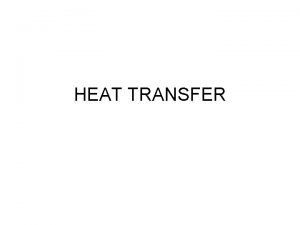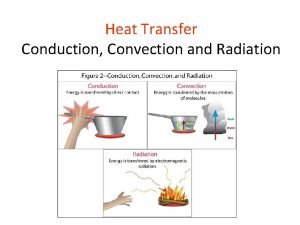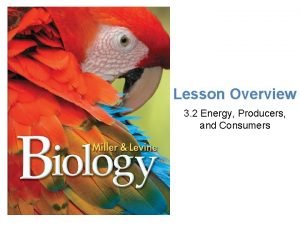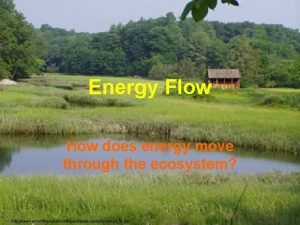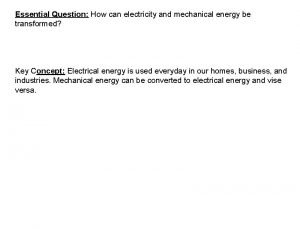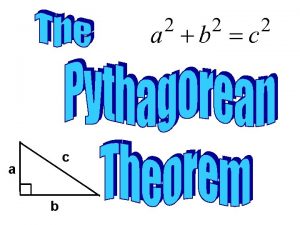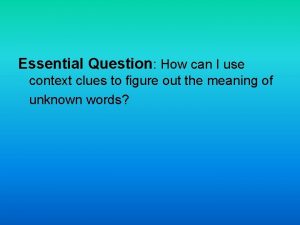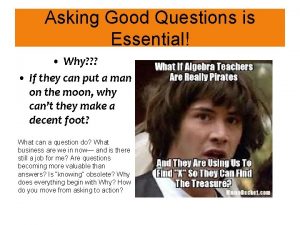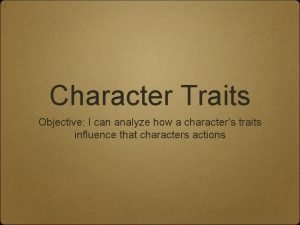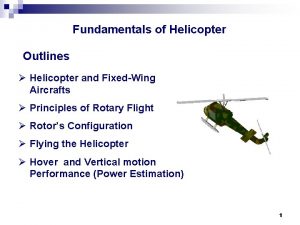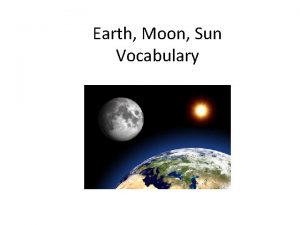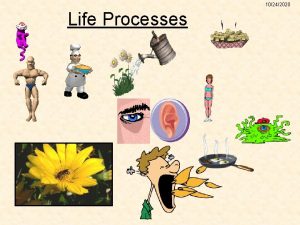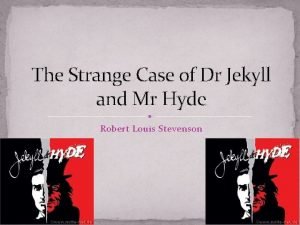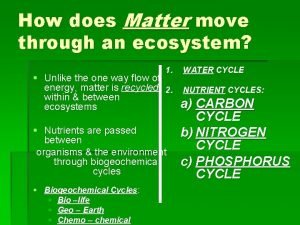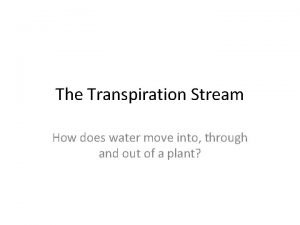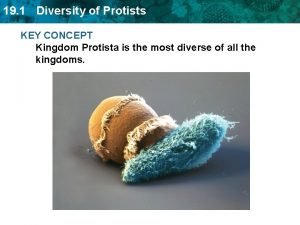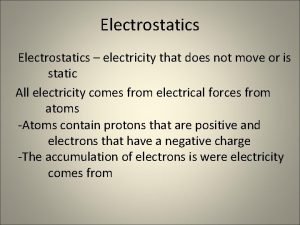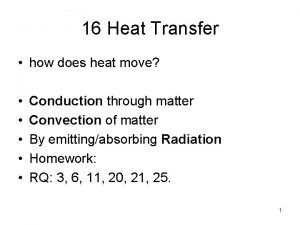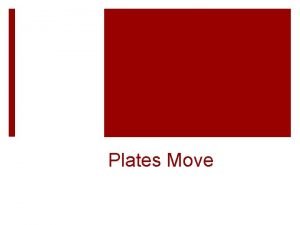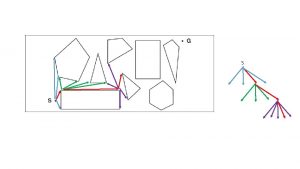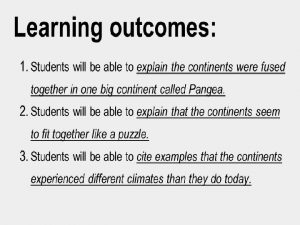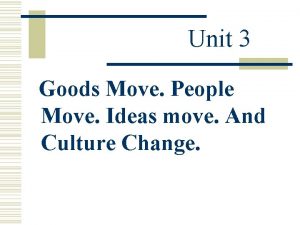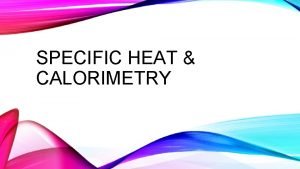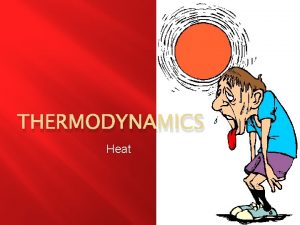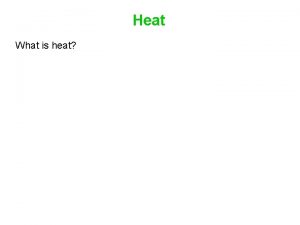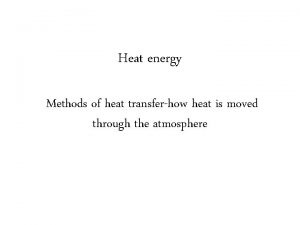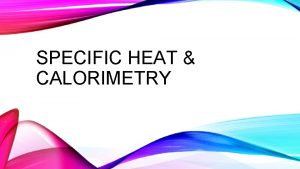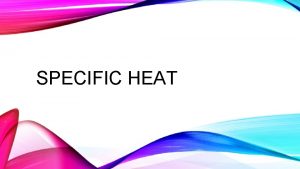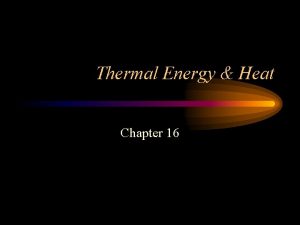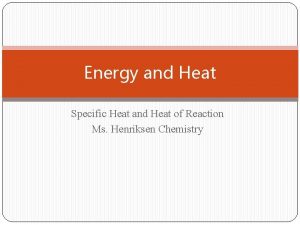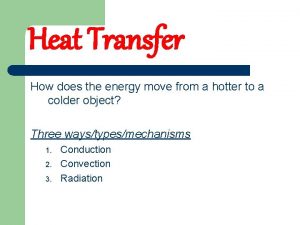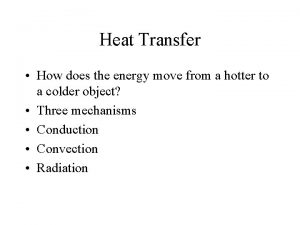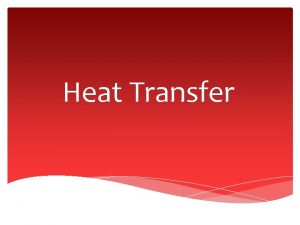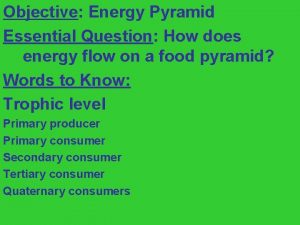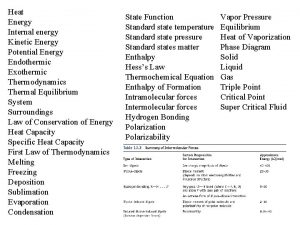Essential Question How does heat energy move from










































- Slides: 42

Essential Question: How does heat energy move from one object to another? Standard: S 8 P 2 d. Plan and carry out an investigations on the effects of heat transfer on molecular motion as it related to the collision of atoms (conduction), through space (radiation), or in currents in a liquid or a gas (convection).

What is thermal energy? *Thermal Energy is the sum of the kinetic and potential energy of the particles that make up a material. (It describes the energy of the particles that make up a solid, liquid, or a gas). *Depends on… 1) temperature of substance (thermal energy increases as temperature increases because as temperature increases, atoms move faster have more kinetic energy) 2) amount of substance (ex: a cup of tea has less energy than a kettle of tea)

What is temperature? *Temperature is the average kinetic energy of the particles that make up a material. NOT dependent on the amount. *The greater the average kinetic energy of particles, the greater the temperature. (ex: the particles in the air in a warm house-lower temp- move faster and have more kinetic energy than those outside on a cold evening-higher temp)

Thermal Energy vs. Temperature *Thermal energy and temperature are related, but not the same. (ex: As a frozen pond melts, both ice and water are present and they have the same temperature. So the particles that make up the ice and water have the same average kinetic energy, or speed. However, the particles do not have the same thermal energy. This is because the average distance of the particles that make up the liquid water and ice are different. The particles that make up the liquid and the solid water have different potential energies and, therefore, different thermal energies)

What is heat? * Heat is the movement of thermal energy from a warmer object to a cooler object. *Heat is transferred only when two objects are at different temperatures. (ex: holding a cup of hot chocolate- thermal energy from the cup heats your hands, or the cup is heating your hands) *All objects have thermal energy. However, you heat something when thermal energy transfers from one object to another.

*Heat is transferred among molecules/atoms. *the rate at which heating occurs depends on the difference in temperatures between the two objects. *The warmer object loses thermal energy and becomes cooler as the cooler object gains thermal energy and becomes warmer. *Heat will continue to move until all materials are at the same temperature.

Applying HEAT increases KINETIC ENERGY in a substance. Notice the “energy” in the molecules in the diagram below. The higher the temperature the molecules expand begin to move away from each other. http: //www. middleschoolchemistry. com/multimedia/chapte r 1/lesson 2#heating_and_cooling

Heat Transfer can occur in three ways: Conduction Convection Radiation

Conduction • Heat is transferred through solids and liquids by direct contact -collision of particles. NOT EMPTY SPACE---but can occur in solids, liquids, & gas. (thermal energy is transferred via colliding molecules/atoms) DRAW THIS!!

Conduction Why is conduction easier in solids and liquids? Atoms and molecules are closer together in solids and liquids. So, the particles need to move only a short distance before they bump into one another and transfer energy.

Explain the movement of thermal energy in the picture below.

Faster moving molecules in your warm hand bump against the slower moving molecules in the ice. Thermal energy moves from your warmer hand to the colder ice. The slow moving molecules in the ice move faster.

How is this an example of Conduction? Faster moving molecules in your warm hand bump against the slower moving molecules in the ice to transfer thermal energy. Direct contact of the particles occurs; therefore, heat is transferred by Conduction.

Conduction Animation: http: //www. passmyexams. co. uk/GCSE/ physics/conduction-heat-transfer. html Eureka Video clip: http: //www. youtube. com/watch ? v=Yitiw 6 Y 7 x. Zg

Your turn…Explain the movement of thermal energy if you were about to eat the Chinese food below. How is this an example of Conduction?

Why does the lady in the pink dress drop her roasting stick before the lady in the green dress?

Conductors and Insulators *A thermal conductor is a material through which thermal energy flows easily. *A thermal insulator is a material through which thermal energy does not flow easily.

Conductors and Insulators

Convection *Note: molecules collide in a liquid or gas-this is an energy transfer of conduction-which leads to convection currents. *Convection is the flow of currents in a liquid or gas. *The transfer of thermal energy by the movement of particles from one part of a material to another.

*As liquids or gases warm up at the bottom, the molecules rise to the top (expand-become less dense) *The cooling process at the top causes the denser liquid or gas to sink. *The cycle repeats until all the water is at the same temperature. DRAW THIS!!

Everyday Examples of Convection Currents http: //www. healthyheating. com/Definitions/heat-transfer -convection. htm#. VD 7 SIfmj. OSo


Convection Animations and Video Clips http: //www. passmyexams. co. uk/GCSE/ physics/convection-heat-transfer. html Eureka Video clip: http: //www. youtube. com/watch? v =ON 2 Y 3 FEk_UI

Convection Describe an example of convection that you have experienced recently at home, at school, or outside.

How Hot was it? Dashboard Oven Hot What cooked the cookies?

Radiation * Radiation is heat transfer through space (not matter) by electromagnetic waves DRAW THIS *Unlike Conduction and Convection, Radiation can occur in empty space (a vacuum), as well as in solids, liquids, and gases. *Waves such as visible light, infrared, and ultraviolet light are examples of radiation


Radiation

Radiation Eureka video clip: http: //www. youtube. com/watc h? v=2 JZci. Wt. K 6 vc

Animations of Heat Transfer http: //www. pbslearningmedia. org/asse t/lsps 07_int_heattransfer/ https: //www. eeducation. psu. edu/egee 102/node/2053 Scroll down for animations

Look at the examples of Heat Transfer in the Image below


Which type of heat transfer?

Which type of heat transfer?

Heat Transfer Song http: //www. youtube. com/wa tch? v=wr 8 Z 4 SCETPs

Look at the three images below. Identify which is an example of conduction, convection, and radiation. A. B. C.

Look at the three images below. Identify which is an example of conduction, convection, and radiation.

When water boils in a pan on a hot burner, heat gets to the water mainly by… a) radiation of heat through the pan b) reflection of heat from the burner c) conduction of heat through the pan d) absorption of heat from the air in the room

Alex’s mother asked him to use a spoon to stir the stew that was cooking on the stove. Which spoon will stay the coolest while he stirs? a) an iron spoon b) a silver spoon c) a wooden spoon d) an aluminum spoon

Patti used a steel wrench to work on her bicycle on a hot, sunny day. She left the wrench on the hot concrete surface for an hour while she had lunch. When she returned, the wrench was very hot to touch. What is the BEST explanation for how the wrench got so hot? A. Heat transferred from the wrench to the air. B. Heat transferred from the bicycle to the wrench. C. Heat transferred from the wrench to the concrete. D. Heat transferred from the concrete to the wrench.

Which statement is an example of heat transfer by convection? A. Jane's feet burned as she walked across the hot beach sand. B. Hot air from the sand rose and was replaced by cool air blowing in from the ocean. C. The black asphalt of the parking lot was much warmer than the green grass surrounding the lot. D. People were scattered across the beach, sitting on chairs and towels, warming themselves in the bright sunshine.

Heat Transfer Summarizer
 How does heat move
How does heat move Sunlight melts a wax crayon left outside.
Sunlight melts a wax crayon left outside. Example of radiation heat transfer
Example of radiation heat transfer Examples of costa's level 3 questions
Examples of costa's level 3 questions What has roads but no cars rivers but no water
What has roads but no cars rivers but no water How does energy move through the biosphere
How does energy move through the biosphere Do birds eat squirrels
Do birds eat squirrels How does energy move
How does energy move Cse 142 critters
Cse 142 critters Characteristics of lipids
Characteristics of lipids How are thermal energy and temperature different
How are thermal energy and temperature different Heat energy transfer
Heat energy transfer Essential questions for figurative language
Essential questions for figurative language Formula hipotenusa triangle rectangle
Formula hipotenusa triangle rectangle Essential question generator
Essential question generator Pythagorean theorem essential questions
Pythagorean theorem essential questions Essential questions for figurative language
Essential questions for figurative language Individual vs society
Individual vs society Essential context clues
Essential context clues Cornell notes essential question
Cornell notes essential question What makes a question essential
What makes a question essential Essential questions for multiplication
Essential questions for multiplication Essential question gif
Essential question gif Internal and external character traits
Internal and external character traits Cornell way
Cornell way Essential questions poetry
Essential questions poetry Energy energy transfer and general energy analysis
Energy energy transfer and general energy analysis Energy energy transfer and general energy analysis
Energy energy transfer and general energy analysis Elastic energy transfer
Elastic energy transfer Water balance in plants
Water balance in plants How does a helicopter move forward
How does a helicopter move forward How does the air move in a sea breeze?
How does the air move in a sea breeze? Electrolysis gel
Electrolysis gel How do helicopters move forward
How do helicopters move forward Does the sun and moon move
Does the sun and moon move How do horses move in chess
How do horses move in chess Do plants move on their own
Do plants move on their own Edward hyde
Edward hyde How does matter move
How does matter move Transpiration stream meaning
Transpiration stream meaning Diverse diverse
Diverse diverse What do volvox eat
What do volvox eat Electricity that does not move
Electricity that does not move

